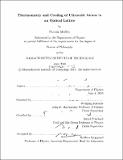| dc.contributor.advisor | Wolfgang Ketterle and David Pritchard. | en_US |
| dc.contributor.author | Medley, Patrick (Patrick M.) | en_US |
| dc.contributor.other | Massachusetts Institute of Technology. Dept. of Physics. | en_US |
| dc.date.accessioned | 2012-01-30T17:07:18Z | |
| dc.date.available | 2012-01-30T17:07:18Z | |
| dc.date.copyright | 2010 | en_US |
| dc.date.issued | 2010 | en_US |
| dc.identifier.uri | http://hdl.handle.net/1721.1/68977 | |
| dc.description | Thesis (Ph. D.)--Massachusetts Institute of Technology, Dept. of Physics, 2010. | en_US |
| dc.description | Cataloged from PDF version of thesis. | en_US |
| dc.description | Includes bibliographical references (p. 127-132). | en_US |
| dc.description.abstract | Ultracold atoms of 7Rb were prepared in a mixture of two hyperfine states, F 1, mF = -1 > and 2, -2 >. This two-component system was then studied in the presence of a magnetic field gradient and an optical lattice. The presence of a magnetic field gradient separated the atoms into regions of opposite spin, with a boundary region of mixed spin in the center. In the presence of an optical lattice, the width of this region was found to be proportional to the system's temperature and inversely proportional to the strength of the magnetic field. This allowed the measurement of the size of the boundary region to act as a thermometer for the system, representing the first demonstration of spin gradient thermometry. This thermometer represents the first practical method for thermometry in the Mott insulator, and has features of high dynamic range and tunable sensitivity. Given sufficient optical resolution and control over the magnetic field gradient, the lower limit of this thermometer is set by quantum magnetic ordering effects. The dynamic response of this system to changes in magnetic field gradient was studied, both in the weak and strong lattice regimes. The result of these studies was the development of spin gradient demagnetization cooling. By performing an adiabatic drop in gradient strength while still in the superfluid, significant cooling of the entire system was observed. When the same process was performed in the Mott insulator, the spin temperature was cooled dramatically, while remaining out of equilibrium with the remaining degrees of freedom of the system. By reversing the gradient direction, inverted spin populations with negative temperatures have been produced. Spin gradient demagnetization has produced the closest approach to absolute zero yet recorded: 300 pK for the equilibrated system, and spin temperatures of 75 pK as well as -75 pK. The ability to achieve these temperatures puts studies of quantum magnetism in optical lattices within reach. | en_US |
| dc.description.statementofresponsibility | by Patrick Medley. | en_US |
| dc.format.extent | 132 p. | en_US |
| dc.language.iso | eng | en_US |
| dc.publisher | Massachusetts Institute of Technology | en_US |
| dc.rights | M.I.T. theses are protected by
copyright. They may be viewed from this source for any purpose, but
reproduction or distribution in any format is prohibited without written
permission. See provided URL for inquiries about permission. | en_US |
| dc.rights.uri | http://dspace.mit.edu/handle/1721.1/7582 | en_US |
| dc.subject | Physics. | en_US |
| dc.title | Thermometry and cooling of ultracold atoms in an optical lattice | en_US |
| dc.type | Thesis | en_US |
| dc.description.degree | Ph.D. | en_US |
| dc.contributor.department | Massachusetts Institute of Technology. Department of Physics | |
| dc.identifier.oclc | 774024120 | en_US |
